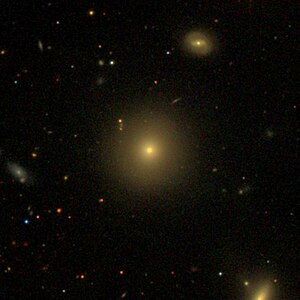NGC 2809
| Galaxy NGC 2809 |
|
|---|---|

|
|
| LEDA 1615127 (l), NGC 2809, IC 2457 (ro), SDSS | |
| AladinLite | |
| Constellation | cancer |
|
Position equinox : J2000.0 , epoch : J2000.0 |
|
| Right ascension | 09 h 17 m 06.9 s |
| declination | + 20 ° 04 ′ 11 ″ |
| Appearance | |
| Morphological type | S0 |
| Brightness (visual) | 12.9 mag |
| Brightness (B-band) | 13.9 likes |
| Angular expansion | 1.3 ′ × 1.2 ′ |
| Position angle | 171 ° |
| Surface brightness | 13.3 mag / arcmin² |
| Physical data | |
| Affiliation | WBL 213-005 |
| Redshift | 0.027863 ± 0.000087 |
| Radial velocity | 8353 ± 26 km / s |
|
Stroke distance v rad / H 0 |
(369 ± 26) x 10 6 ly (113.2 ± 7.9) Mpc |
| history | |
| discovery | John Herschel |
| Discovery date | February 24, 1827 |
| Catalog names | |
| NGC 2809 • UGC 4910 • PGC 26220 • CGCG 091-054 • MCG + 03-24-033 • 2MASX J09170689 + 2004108 • GALEX ASC J091707.02 + 200410.8 • LDCE 622 NED013 | |
NGC 2809 is a lenticular galaxy of Hubble type S0 in the constellation Cancer on the ecliptic . It is estimated to be 369 million light-years away from the Milky Way and has a diameter of about 140,000 ly
. a. the galaxies NGC 2804 , NGC 2806 , NGC 2807 , IC 2457 .
The object was discovered on February 24, 1827 by the astronomer John Herschel .
